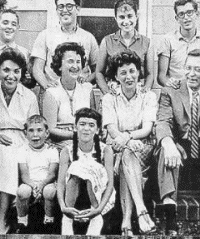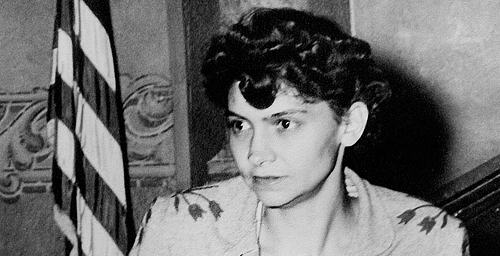Introduction At an absolute minimum, the Establishment Clause was intended to prohibit the federal government from declaring and financially supporting a national religion, such as existed in many other countries at the time of the nation's founding. It is far less clear whether the Establishment Clause was also intended to prevent the federal government from supporting Christianity in general. Proponents of a narrow interpretation of the clause point out that the same First Congress that proposed the Bill of Rights also opened its legislative day with prayer and voted to apportion federal dollars to establish Christian missions in the Indian lands. On the other hand, persons seeing a far broader meaning in the clause point to writings by Thomas Jefferson and James Madison suggesting the need to establish "a wall of separation" between church and state. Supreme
Court interpretation of the Establishment Clause
does not begin until 1947 in Everson v Board
of Education. Voting 5 to 4, the Court
upheld a state law that reimbursed parents
for the cost of busing their children to parochial
schools. (It was clear from the various
opinions in Everson that if the state had
reimbursed the parochial schools for the cost of
providing the transportation, that it would have
been found to violate the Establishment
Clause.) Although in his majority opinion
Justice Black wrote of the "wall of separation"
that the Constitution maintains between church and
state, Black viewed the aid in question of serving
the state's secular interest in getting kids
"safely and expeditiously" to schools. The
case is noteworthy for its extensive discussion of
the purposes of the Establishment Clause, and for
the fact that all nine justices agree that the
clause was intended to do far more than merely
prohibit the establishment of a state religion.
Subsequent decisions make clear that a majority of justices on the Supreme Court view "the wall" separating church and state more as a shifting, porous barrier. Small factual differences in cases often produce different outcomes. For example, in 1948, the Court ruled 8 -1 in McCollum v Board of Education that the practice of inviting religious instructors into public schools to give optional religious instruction violates the Establishment Clause. Justice Black, writing for the Court, said that the practice was "unquestionably" a violation of the Establishment Clause, which created "a high and impregnable wall" between church and state. The McCollum decision was the first victory ever for a plaintiff challenging state religious practices under the Establishment Clause. McCollum was distinguished in the 1952 case of Zorach v Clauson, raising the question of the constitutionality of off-premises religious instruction. In Zorach, the Court upheld the practice of giving public school students "release time" so that they could attend religious programs in churches in synagogues. Writing for the 6-3 Court majority in Zorach, Justice Douglas said the Constitution does not require "callous indifference to religion." In dissent, Justice Jackson argued that the state was using the public school as "a temporary jail" for students who chose not to attend the religion classes. The question of school-sponsored prayer has, of course, proven highly controversial. In the landmark case of Engel v Vitale in 1962, the Court ruled that New York's practice of beginning school days with a prayer drafted by school officials violated the Establishment Clause. This is the case, the Court said, whether or not students are given the option of not participating in the prayer. Following Engel, the Court has faced a whole series of prayer-related cases in the public school context raising issues such a prayer in special circumstances (e.g., graduation ceremonies), periods for silent meditation or silent prayer, and student-initiated prayer. In general, the Court has demonstrated a willingness to strike down any practices that might be likely to be perceived either as coercive or as a state endorsement of religion.  Happy members of the group that challenged New York's daily prayer in Engel v Vitale. Other Religion Clause Topics: Prayer in the Public Schools Financial Aid to Religious Schools Theocracy Issues: Looking for Secular Purposes Religious Symbols in Public Places Student-Initiated Religious Speech Laws Burdening Religiously-Motivated Conduct |
Everson v Board of Education
(1947)
Questions 2. If it were to be satisfactorily demonstrated that a majority of those voting to propose and ratify the First Amendment had a narrow view of the application of the Establishment Clause, should the Court reverse course and overrule many of its established precedents in this area? 3. What do you think about the suggestion made by Professor Laurence Tribe and others that "religion" should be given two interpretations--a narrow one for Establishment Clause purposes and a broad one for Free Exercise Clause purposes? Two
Justice's Views
To
hold that a state cannot, consistently with the
First and Fourteenth Amendments, utilize its
public school system to aid any or all religious
faiths or sects in the dissemination of their
doctrines and ideals does not...manifest a
governmental hostility to religion or religious
teachings. A manifestation of such hostility would
be at war with our national tradition as embodied
in the First Amendment's guaranty of the free exercise of
religion. For the First Amendment rests upon the
premise that both religion and government can best
work to achieve their lofty aims if each is left
free from the other within its respective sphere.
Or, as we said in the Everson case, the
First Amendment has erected a wall between Church
and State which must be kept high and impregnable.
(Justice Black in
McCollum v Board of
Education)
We are a religious people whose institutions presuppose a Supreme Being. We guarantee the freedom to worship as one chooses. We make room for as wide a variety of beliefs and creeds as the spiritual needs of man deem necessary. We sponsor an attitude on the part of government that shows no partiality to any one group and that lets each flourish according to the zeal of its adherents and the appeal of its dogma. When the state encourages religious instruction or cooperates with religious authorities by adjusting the schedule of public events to sectarian needs, it follows the best of our traditions. For it then respects the religious nature of our people and accommodates the public service to their spiritual needs. To hold that it may not would be to find in the Constitution a requirement that the government show a callous indifference to religious groups. (Justice Douglas in Zorach v Clauson) |


